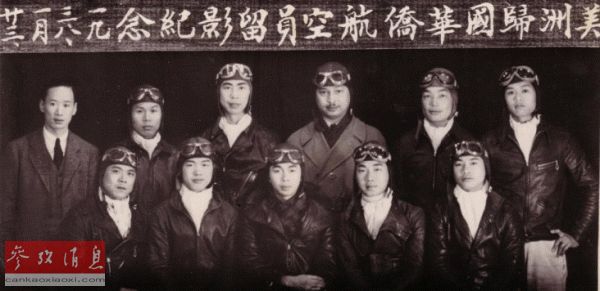Forgotten history: Chinese Americans who fought against Japan
- By Zhang Rui
 0 Comment(s)
0 Comment(s) Print
Print E-mail China.org.cn, September 2, 2015
E-mail China.org.cn, September 2, 2015
Thousands of Chinese Americans who returned home to contribute to the Chinese People's War of Resistance Against Japanese Aggression (1931-45) should not be forgotten, Chinese media reported.
|
|
| Chinese-American pilots who joined the fight against Japanese invasion. [File photo] |
Long the victims of racial prejudice and discriminatory immigration practices, Chinese Americans struggled to transform their image in American eyes. The Chinese Exclusion Act was in effect from 1882 to 1943, so that many Chinese couldn't find any sense of belonging in the U.S. no matter how long they stayed. And they deeply felt for what was happening in their motherland.
According to the memoirs of Chinese air force hero Yu Yuzong, the September 18th Incident, a pretext for the Japanese invasion in 1931 of northeastern China, shocked Chinese communities in America. Just 20 days after the incident, the Chinese-American Aviation School sponsored by Chinese Americans opened in Portland, Oregon, and trained 36 pilots over two terms. Of these, 25 returned to China after graduation to serve in the air force, among them being Wong Pan-Yang and Arthur Chin, later to become war heroes.
In 1932 alone, more than 5,000 young Chinese Americans registered for training, ready to return to China to fight in the war.
Another Chinese American aviation school was also founded in 1933 in San Francisco and trained more than 70 pilots who also joined the fight against Japanese invasion. Chinese in Chicago and New York also founded such schools or opened classes in existing aviation schools. According to the late esteemed Chinese American scholar and historian Him Mark Lai, about 200 Chinese American aviation talents returned to defend their motherland.
The aviation hero Wong Sun-Shui was one of them who joined the Guangdong air force and fought in over a hundred air battles, shooting down eight Japanese aircrafts. He eventually died in a crash.
According to statistics, the Guangdong air force mostly comprised overseas Chinese. Later, General Claire Lee Chennault created the famous "Flying Tigers," officially known as the American Volunteer Group, whose ground crew were mostly Chinese Americans.
The father of K. Scott Wong, a professor of History & Public Affairs at Williams College, was a member of the Flying Tigers. Wong told Reference News that, at the beginning of World War II, there were 80,000 Chinese in mainland America and Hawaii. During the war, 12,000 to 15,000 Chinese served in U.S. army in various battlefields in Europe, north Africa and Asia. There were 1,200 Chinese American soldiers fighting in China.
Wong has written a book entitled "Americans First: Chinese Americans and the Second World War." In his book, he also wrote about Chinese Americans' fund raising campaign to support the war against Japan. A California Chinese organization raised more than US$30,000 in a week at that time. Many Chinese, including those at the lowest level, such as laundrywomen and garment factory workers, in New York and California states donated all their savings. They also organized demonstrations and called on local Chinese to join the Chinese army engaged in the war.
According to the former Chinese government (Republic of China) statistics, four million overseas Chinese donated to the war effort, accounting for 43 percent of China's military expenditure.
The Flying Tigers and the U.S. 14th Air Force are famous stories during the war with the support by then president Franklin D. Roosevelt and General Dwight Eisenhower. According to Wong, there were about 1,200 Chinese Americans in the Flying Tigers. In July 1942 the Flying Tigers was disbanded and was replaced by the 23rd Fighter Group of the United States Army Air Force, later absorbed into the 14thAir Force. American statistics show that this unit shot down 2,315 Japanese aircrafts, a great achievement.
But memories of Chinese Americans who joined the war against Japan are fading. Peter Woo, chairman of New York's American Legion Lt Kimlau Chinese Memorial Post 1291, said many veterans have passed on, and, "currently, there are less than 100 Chinese American veterans alive who have fought in the World War II, and they are not in good health now."
Another Chinese veteran told Reference News he hoped the world, especially the Chinese people, would never forget their contribution and sacrifice.
And his wish should be granted.
Chinese American Florence Fang has worked tirelessly over the past year to lead a group of volunteers to create the first overseas memorial to commemorate those who fought in the war against Japanese aggression. Fang, curator of WWII Pacific War Memorial Hall, announced at a press conference in Beijing that the venue opened in San Francisco in August, collecting a mass of historic items including Flying Tigers' parachutes. She said they will have exhibitions in China in the future.
Hundreds of thousands of overseas Chinese have participated in dozens of commemorative events in many countries around the world such as America, Russia, France, Japan, Germany, Canada and Australia, Beijing Morning Post reported.







Go to Forum >>0 Comment(s)